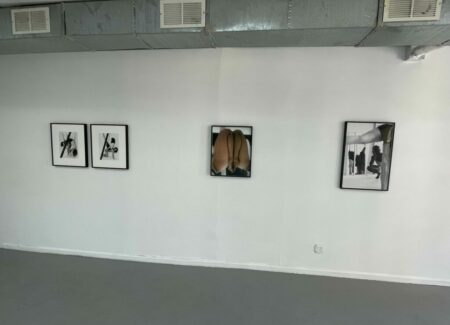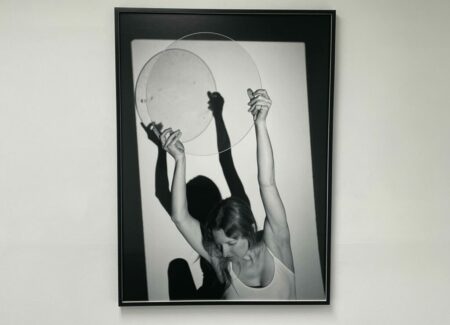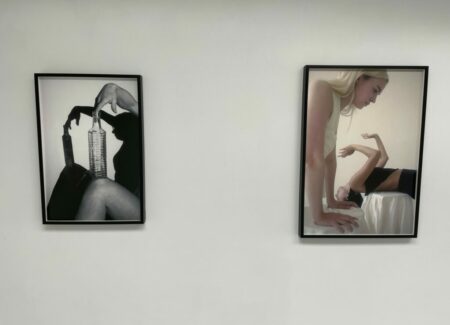JTF (just the facts): A total of 14 black-and-white and color photographs, generally framed in black and unmatted, and hung against white walls in the two room gallery sapce.
The following works are included in the show:
- 1 archival pigment print, 2023, sized roughly 20×15 inches, in an edition of 3+2AP
- 1 archival pigment print, 2023, sized 24×16 inches, in an edition of 3+2AP
- 1 archival pigment print, 2023, sized 24×20 inches, in an edition of 3+2AP
- 1 archival pigment print, 2022, sized 26×20 inches, in an edition of 3+2AP
- 1 archival pigment print, 2023, sized roughly 28×20 inches, in an edition of 3+2AP
- 1 archival pigment print, 2023, sized roughly 31×20 inches, in an edition of 3+2AP
- 3 archival pigment prints, 2023, sized 40×30 inches, in editions of 3+2AP
- 1 archival inkjet print, 2022, sized roughly 28×22 inches, in an edition of 3+2AP
- 2 gelatin silver prints, 2023, sized roughly 14×11 inches, in editions of 3+2AP
- 1 gelatin silver print, 2023, sized roughly 16×12 inches, in an edition of 3+2AP
- 1 gelatin silver print, 2023, sized 31×20 inches, in an edition of 3+2AP
(Installation shots below.)
Comments/Context: Jenna Westra’s photographs have always skirted the edge between chance and intention, where the poses of the female models in the artist’s studio might have been directed in a choreographed manner or maybe they were just serendipitous temporary arrangements. Performance and accident are intimately intertwined in Westra’s images, leaving us to wonder about what assumptions we as viewers bring to the bodies we are shown, and how those reactions influence our interpretation of Westra’s staged scenes and formal experiments.
The works in this show build on the aesthetics from Westra’s 2020 gallery show (reviewed here), perhaps with a little less dance-like partnering and overt lyricism. The movements and setups found in her new pictures feel more structured and architectural than before, her use of mirrors, shadows, and visual interruptions creating more opportunities for unexpected doubling and layered interaction.
Westra’s black-and-white image of a circle of women pulling on a group of wire hangers is the most satisfyingly confusing photograph in the show. Shot from above, it recalls the spinning motion of Henri Matisse’s dancers, but with a more intimate view of the reaching in tangle of arms and legs. Another pair of black-and-white images is more overtly a stunt, with one woman stacked on top of another in inverted modes, with the slash of an angled black pole cutting through the arrangements. But all the folding and bending of bodies in these images isn’t necessarily so mannered, as seen in a color photograph of a woman lying on her side and reading a book, the lines of her hips and her raised arm creating their own singular geometries.
Westra introduces mirrors of different kinds into several of her compositions, creating a predictable set of reflections and doublings. But she works hard to get beyond the obviousness of the mirroring, turning an image of a kneeling woman in fishnet stockings on its side to reorient the doubling effect, and placing a mirror on the floor near a woman lifting her hips high in the air, with the mirror showing us the view upward as interrupted by a scattering of arms. The strongest of the mirrored setups is found in “Leg Frame”, where one squatting woman is framed by the raised leg of a second, with the pair of mirrors standing near the side wall of the studio reflecting the interaction from an alternate vantage point; the flattening eye of the camera pulls all of these forms into one precisely arranged composition, the space neatly compressed underneath the reaching leg.
Another group of black-and-white photographs engages in clever monochrome shadow play, casting light across posed foreground bodies to create shadows against the back wall. “Projection (Big Moon)” recalls the nudes of František Drtikol, with its circular glass plate held dramatically aloft, while “Projection (Vase)” features a glass bottle posed on a nude knee, with an elegant draped hand holding the bottle in place and casting an elongated shadow. “Safara with Leaf” is the most intricate of these compositions, with an extended arm holding a sprig of spiky greenery doubled by its shadow, the curve of the model’s hips creating a sinuous landscape-like shadow hump, and her raised feet similarly intertwined and doubled.
When Westra moves back to working in color, additional aesthetic approaches come forward. A pair of works brings together two models, one with light hair and white clothing, the other with dark hair and black clothing, and alternately poses them in an overlapped pile (with their contrasting heads merging) and in straight/bent opposition (in an above and below arrangement), adding the light/dark color matching to the choreographic possibilities. Still other works in color use image projection to create layered body effects, and veiling with transparent bubble wrap to texturally interrupt our view of bare skin.
Westra seems keenly aware of how the female body has been seen across the history of photography (particularly by male photographers), and her recent images alternately engage with those aesthetics, reject them, and reinterpret them. In many cases, her images feel vaguely familiar, and yet they have been filtered through and reoriented by a contemporary female vantage point, creating a new set of implications and resonances. What I take away most from this show is Westra’s consistent experimentation within the constraints of the body posed in the studio – this is an artist still actively testing and searching, restlessly recombining the available variables and looking for moments of magic.
Collector’s POV: The prints in this show range in price from $1500 to $3000 based on size. Westra’s work has little consistent secondary market history so gallery retail remains the best option for those collectors interested in following up.
















